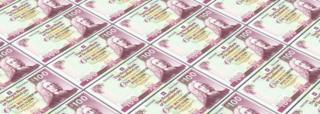What are the Scottish government's Gers figures?
 Image copyright
Getty Images
Image copyright
Getty Images
The Scottish government's latest Government Expenditure and Revenue Scotland (Gers) report is to be published on Wednesday morning.
The report estimates the difference between what Scotland raises in taxation and what is spent on its public services, and has been at the centre of the independence debate in recent years.
Last year's figures put Scotland's public spending deficit at £12.6bn, which was £1.2bn lower than the previous year. The deficit for the UK as a whole was £23.5bn.
The new report will cover the 2019/20 tax year, which ended on 5 April - so the full economic impact of the coronavirus pandemic will not be reflected in the figures.
How did Gers come about and how has it been used?
The Gers figures were first published in 1992 under the then UK Prime Minister John Major.
Conservative ministers in the Scottish Office thought it would help inform the debate on devolution - or would at least help them make the case against the establishment of a Scottish Parliament.
Oil prices were low at the time and they thought the numbers would show how much more Scotland gained from the UK Treasury than it sent south in tax revenues.
Even though the figures have been compiled by the Scottish government since devolution in 1999, there is still an annual battle to interpret the numbers from either side in the independence debate.
The profitability of offshore oil and gas makes a big difference to Scottish public finances, with North Sea oil revenues falling from about £11bn in 2011/12 to just over £1.4bn in last year's figures.
At the time of the independence referendum in 2014, the Scottish government's White Paper described Gers as "the authoritative publication on Scotland's public finances".
The SNP's recent Growth Commission report on the finances of an independent Scotland also accepted the Gers figures as its starting point.
Meanwhile, opponents of independence have used the figures to point to a "Union dividend" - arguing that Scotland can only afford its relatively high levels of public spending because it is part of the UK.
Does Gers tell us what an independent Scotland would look like?
No. The Gers figures are not meant to be anything other than a way of showing the current position under the present arrangements.
Economists at the respected Fraser of Allander Institute say that Gers "presents a useful starting point for a discussion regarding the challenges and opportunities that Scotland would face".
And BBC Scotland's economics editor Douglas Fraser says: "One way of looking at them is to measure how big Scotland's deficit would be, if the country were to have been both independent and if its public finances were performing exactly as they did within the UK.
"It would probably perform rather differently if Holyrood pulled the tax, spending and borrowing levers in different ways to the Treasury in London.
"It could have pulled those levers in a smarter way, or left a bigger deficit.
"Everything around this is contested. But what can be said is that this helps illustrate the health or weakness of Scottish public finances."
How is Gers calculated?
The Fraser of Allander Institute has tried to explain how Gers is compiled by Scottish government statisticians.
It points out that data on the spending side of the equation is not estimated, but some UK spending is allocated to Scotland on a proportional basis.
The total spend is made up of Scottish and local government services, UK welfare spending and pensions in Scotland, and UK government (non-devolved) spend in Scotland.
This is spending on matters such as defence and debt interest, a proportion of which is apportioned to Scotland.
For revenues, there have been complaints that the data used is not collected for Scotland and has to be estimated from UK figures.
This has been less of an issue in recent years, with Scottish income tax, council tax, business rates, the profits made by Scottish Water, landfill tax, land and building transactions tax and local authority user charges and fees included.
There are other revenues - particularly those collected by HMRC - where estimation is needed.
The Fraser of Allander Institute says "estimates are not unusual in economic statistics".
And the Scottish government says that Gers is a National Statistics publication, which means that it is "produced independently of Scottish ministers and has been assessed by the UK Statistics Authority as being produced in line with the Code of Practice for Official Statistics.
"This means the statistics have been found to meet user needs, to be methodologically sound, explained well and produced free of political interference."
The Scottish government has published answers to a list of frequently asked questions about its Gers figures here.
How does Scotland compare to the rest of the UK?
One of the problems with the Gers figures has been that there were no other official regional breakdowns to compare to Scotland's, so the comparison had to be made to the UK as a whole.
But that has recently changed with the ONS publishing regional breakdowns which show that, outside of London and the east and south east of England, most parts of the UK are estimated to raise less revenue than is spent on their behalf.
Last year's Gers figures said that Scotland's tax take was about £307 per person less than the UK figure - while spending was about £1,660 per person higher than for the UK as a whole.
However, only London and the surrounding areas were thought to raise more per head than Scotland.
And it has long been the case that Scotland has received more money to deliver services such as health, education and economic development because of the geographical challenges it faces in these areas.
Scotland also has a slightly higher number of people entitled to benefits associated with issues such as long-term ill health.